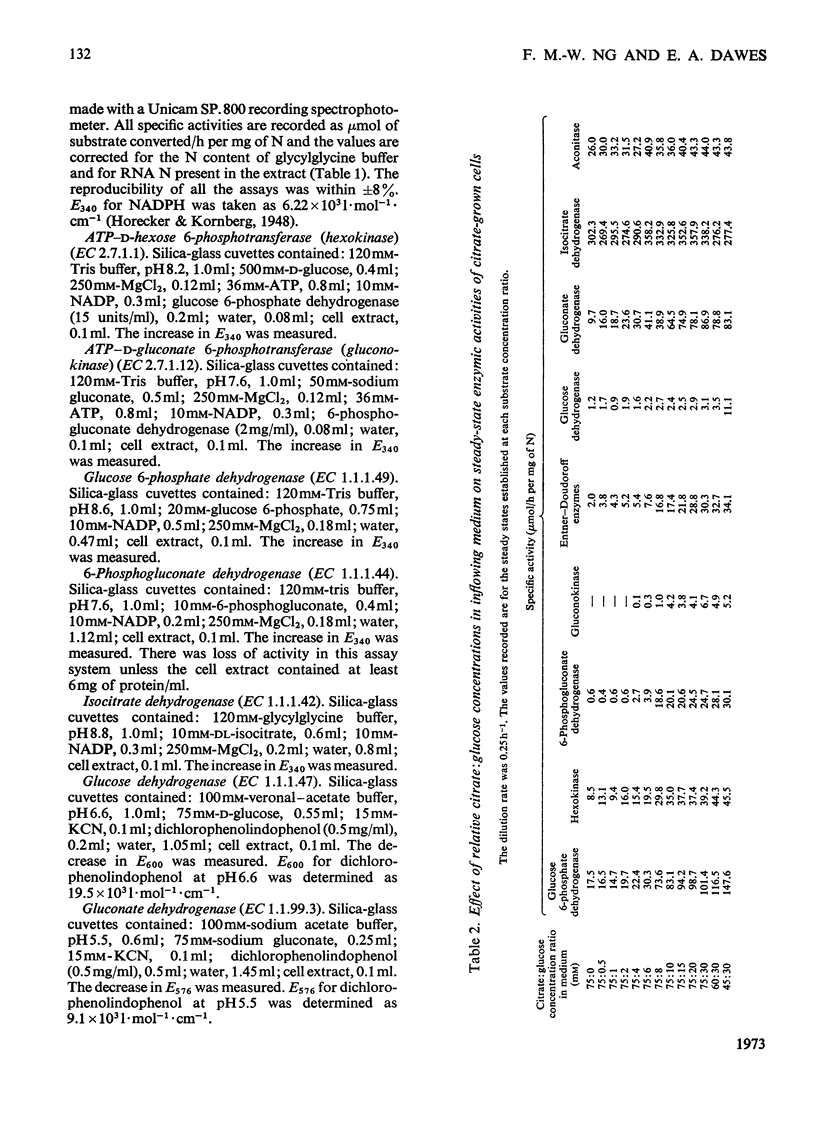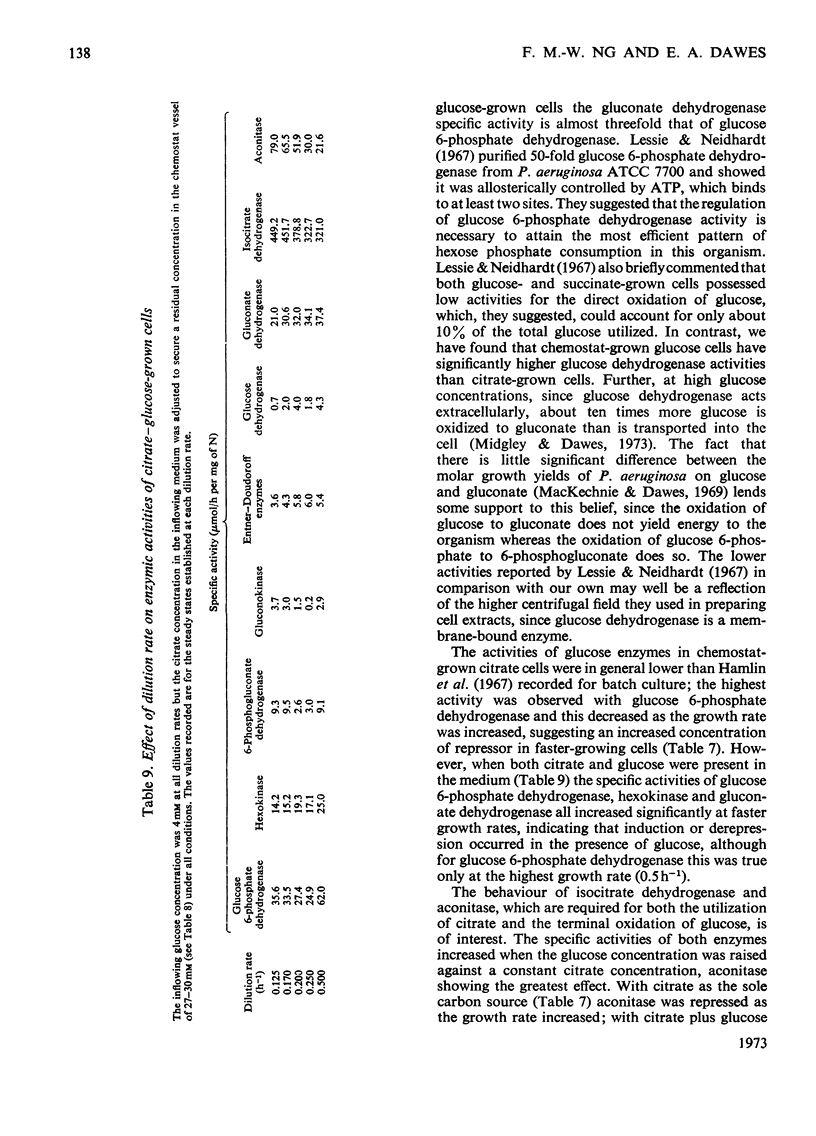Abstract
The effect of the relative concentrations of citrate and glucose on the regulation of key enzymes of the direct oxidative, phosphorylative, Entner–Doudoroff and pentose-cycle pathways of glucose metabolism in Pseudomonas aeruginosa has been investigated in continuous culture under conditions of NH4+-limitation. For comparison isocitrate dehydrogenase and aconitase were also assayed. Measurements were made for steady-state and transient conditions and the effect of growth rate was also studied. When cells grew on 75mm-citrate the glucose concentration had to attain 6–8mm before significant induction of enzymes of glucose metabolism occurred; the specific activities increased further as the result of both raising the glucose concentration to 30mm and then subsequently lowering the citrate to 60mm and then to 45mm. The specific activities of the glucose enzymes increased immediately during the transient period between the steady states characteristic of growth on 6mm- and 8mm-glucose, the increase continuing for about two doubling times. The converse experiment of adding increasing citrate concentrations to 45mm-glucose medium revealed an immediate induction of the citrate-transport system, oxidation of citrate following the increase in citrate concentration up to 8mm. Between 8mm- and 16mm-citrate a marked repression of gluconate, glucose 6-phosphate and 6-phosphogluconate dehydrogenases and the Entner–Doudoroff enzymes occurred. Increased growth rate in citrate medium resulted in decreased specific activities of glucose 6-phosphate dehydrogenase and isocitrate dehydrogenase. Increased growth rate in citrate–glucose medium gave decreased specific activities of isocitrate dehydrogenase and aconitase whereas the activities of some of the glucose enzymes decreased initially but then increased at the highest growth rate (0.5h−1), at which a marked increase in glucose utilization occurred. These observations accord with the regulation of glucose enzymes by induction with glucose or its metabolites and repression by citrate or its metabolic products.
Full text
PDF











Selected References
These references are in PubMed. This may not be the complete list of references from this article.
- CLARIDGE C. A., WERKMAN C. H. Formation of 2-ketogluconate from glucose by a cell-free preparation of Pseudomonas aeruginosa. Arch Biochem Biophys. 1953 Nov;47(1):99–106. doi: 10.1016/0003-9861(53)90440-8. [DOI] [PubMed] [Google Scholar]
- CLARKE P. H., BRAMMAR W. J. REGULATION OF BACTERIAL ENZYME SYNTHESIS BY INDUCTION AND REPRESSION. Nature. 1964 Sep 12;203:1153–1155. doi: 10.1038/2031153a0. [DOI] [PubMed] [Google Scholar]
- CLARKE P. H., MEADOW P. M. Evidence for the occurrence of Permeases for tricarboxylic acid cycle intermediates in Pseudomonas aeruginosa. J Gen Microbiol. 1959 Feb;20(1):144–155. doi: 10.1099/00221287-20-1-144. [DOI] [PubMed] [Google Scholar]
- DAGLEY S., DAWES E. A. Critic acid metabolism of Aerobacter aerogenes. J Bacteriol. 1953 Sep;66(3):259–265. doi: 10.1128/jb.66.3.259-265.1953. [DOI] [PMC free article] [PubMed] [Google Scholar]
- ENTNER N., DOUDOROFF M. Glucose and gluconic acid oxidation of Pseudomonas saccharophila. J Biol Chem. 1952 May;196(2):853–862. [PubMed] [Google Scholar]
- FLECK A., MUNRO H. N. The precision of ultraviolet absorption measurements in the Schmidt-Thannhauser procedure for nucleic acid estimation. Biochim Biophys Acta. 1962 May 14;55:571–583. doi: 10.1016/0006-3002(62)90836-3. [DOI] [PubMed] [Google Scholar]
- Gray C. T., Wimpenny J. W., Mossman M. R. Regulation of metabolism in facultative bacteria. II. Effects of aerobiosis, anaerobiosis and nutrition on the formation of Krebs cycle enzymes in Escherichia coli. Biochim Biophys Acta. 1966 Mar 28;117(1):33–41. doi: 10.1016/0304-4165(66)90149-8. [DOI] [PubMed] [Google Scholar]
- Herbert D., Phipps P. J., Tempest D. W. The chemostat: design and instrumentation. Lab Pract. 1965 Oct;14(10):1150–1161. [PubMed] [Google Scholar]
- LIU P. Utilization of carbohydrates by Pseudomonas aeruginosa. J Bacteriol. 1952 Dec;64(6):773–781. doi: 10.1128/jb.64.6.773-781.1952. [DOI] [PMC free article] [PubMed] [Google Scholar]
- Lessie T., Neidhardt F. C. Adenosine triphosphate-linked control of Pseudomonas aeruginosa glucose-6-phosphate dehydrogenase. J Bacteriol. 1967 Apr;93(4):1337–1345. doi: 10.1128/jb.93.4.1337-1345.1967. [DOI] [PMC free article] [PubMed] [Google Scholar]
- MANDELSTAM J., JACOBY G. A. INDUCTION AND MULTI-SENSITIVE END-PRODUCT REPRESSION IN THE ENZYMIC PATHWAY DEGRADING MANDELATE IN PSEUDOMONAS FLUORESCENS. Biochem J. 1965 Mar;94:569–577. doi: 10.1042/bj0940569. [DOI] [PMC free article] [PubMed] [Google Scholar]
- MCARDLE B. A modified method for the microdetermination of citric acid. Biochem J. 1955 Aug;60(4):647–649. doi: 10.1042/bj0600647. [DOI] [PMC free article] [PubMed] [Google Scholar]
- Mackechnie I., Dawes E. A. An evaluation of the pathways of metabolism of glucose, gluconate and 2-oxogluconate by Pseudomonas aeruginosa by measurement of molar growth yields. J Gen Microbiol. 1969 Mar;55(3):341–349. doi: 10.1099/00221287-55-3-341. [DOI] [PubMed] [Google Scholar]
- Midgley M., Dawes E. A. The regulation of transport of glucose and methyl alpha-glucoside in Pseudomonas aeruginosa. Biochem J. 1973 Feb;132(2):141–154. doi: 10.1042/bj1320141. [DOI] [PMC free article] [PubMed] [Google Scholar]
- Ng F. M., Dawes E. A. Regulation of enzymes of glucose metabolism by citrate in Pseudomonas aeruginosa. Biochem J. 1967 Sep;104(3):48P–48P. [PMC free article] [PubMed] [Google Scholar]
- POSTGATE J. R., CRUMPTON J. E., HUNTER J. R. The measurement of bacterial viabilities by slide culture. J Gen Microbiol. 1961 Jan;24:15–24. doi: 10.1099/00221287-24-1-15. [DOI] [PubMed] [Google Scholar]
- RAVIN A. W. Heritable and non-heritable loss of ability by Aerobacter aerogenes to grow adaptively on single carbon sources. J Gen Microbiol. 1952 May;6(3-4):211–232. doi: 10.1099/00221287-6-3-4-211. [DOI] [PubMed] [Google Scholar]
- STICKLAND L. H. The determination of small quantities of bacteria by means of the biuret reaction. J Gen Microbiol. 1951 Oct;5(4):698–703. doi: 10.1099/00221287-5-4-698. [DOI] [PubMed] [Google Scholar]
- STOKES F. N., CAMPBELL J. J. R. The oxidation of glucose and gluconic acid by dried cells of Pseudomonas aeruginosa. Arch Biochem. 1951 Jan;30(1):121–125. [PubMed] [Google Scholar]
- Stevenson I. L., Mandelstam J. Induction and multi-sensitive end-product repression in two converging pathways degrading aromatic substances in Pseudomonas fluorescens. Biochem J. 1965 Aug;96(2):354–362. doi: 10.1042/bj0960354. [DOI] [PMC free article] [PubMed] [Google Scholar]
- WANG C. H., STERN I. J., GILMOUR C. M. The catabolism of glucose and gluconate in Pseudomonas species. Arch Biochem Biophys. 1959 Apr;81(2):489–492. doi: 10.1016/0003-9861(59)90229-2. [DOI] [PubMed] [Google Scholar]


